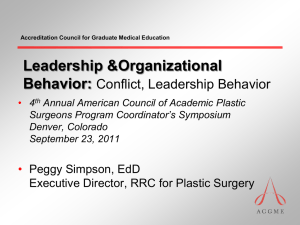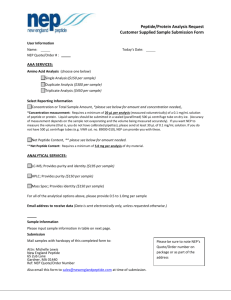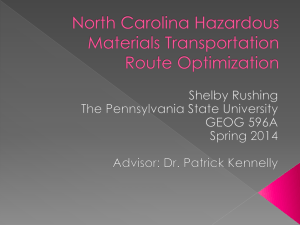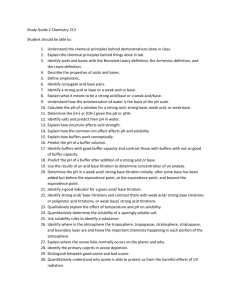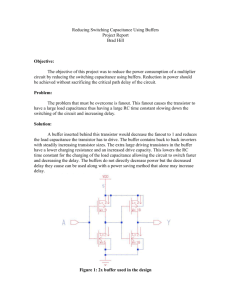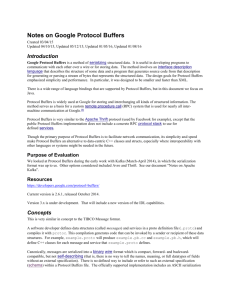document reviewing keys issues
advertisement
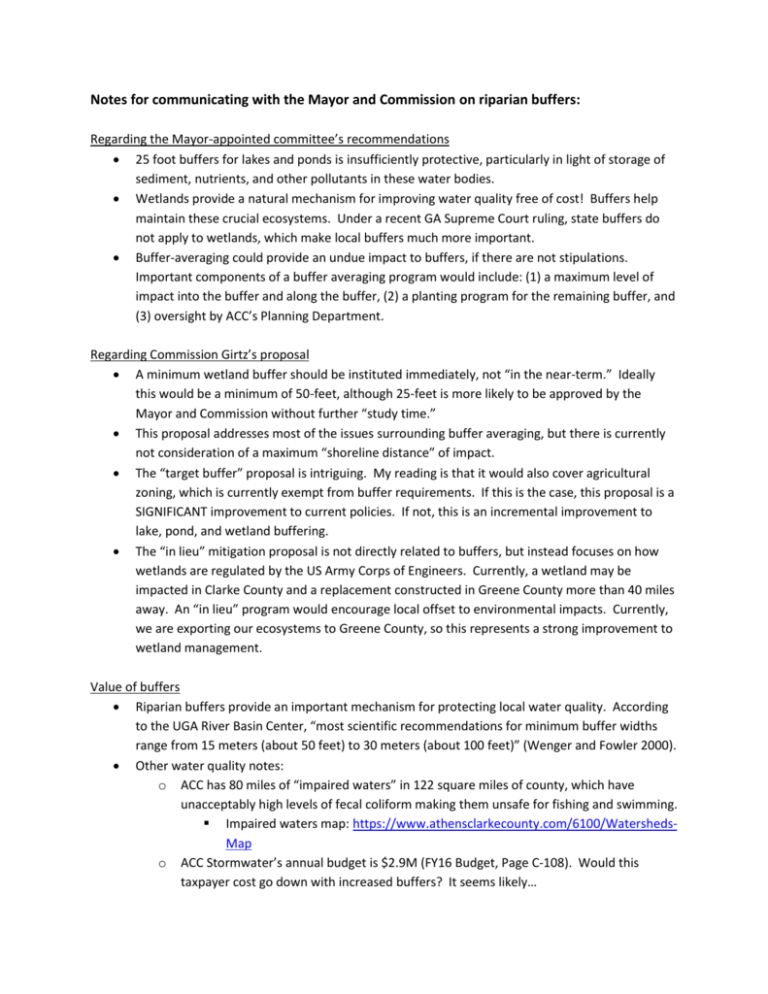
Notes for communicating with the Mayor and Commission on riparian buffers: Regarding the Mayor-appointed committee’s recommendations 25 foot buffers for lakes and ponds is insufficiently protective, particularly in light of storage of sediment, nutrients, and other pollutants in these water bodies. Wetlands provide a natural mechanism for improving water quality free of cost! Buffers help maintain these crucial ecosystems. Under a recent GA Supreme Court ruling, state buffers do not apply to wetlands, which make local buffers much more important. Buffer-averaging could provide an undue impact to buffers, if there are not stipulations. Important components of a buffer averaging program would include: (1) a maximum level of impact into the buffer and along the buffer, (2) a planting program for the remaining buffer, and (3) oversight by ACC’s Planning Department. Regarding Commission Girtz’s proposal A minimum wetland buffer should be instituted immediately, not “in the near-term.” Ideally this would be a minimum of 50-feet, although 25-feet is more likely to be approved by the Mayor and Commission without further “study time.” This proposal addresses most of the issues surrounding buffer averaging, but there is currently not consideration of a maximum “shoreline distance” of impact. The “target buffer” proposal is intriguing. My reading is that it would also cover agricultural zoning, which is currently exempt from buffer requirements. If this is the case, this proposal is a SIGNIFICANT improvement to current policies. If not, this is an incremental improvement to lake, pond, and wetland buffering. The “in lieu” mitigation proposal is not directly related to buffers, but instead focuses on how wetlands are regulated by the US Army Corps of Engineers. Currently, a wetland may be impacted in Clarke County and a replacement constructed in Greene County more than 40 miles away. An “in lieu” program would encourage local offset to environmental impacts. Currently, we are exporting our ecosystems to Greene County, so this represents a strong improvement to wetland management. Value of buffers Riparian buffers provide an important mechanism for protecting local water quality. According to the UGA River Basin Center, “most scientific recommendations for minimum buffer widths range from 15 meters (about 50 feet) to 30 meters (about 100 feet)” (Wenger and Fowler 2000). Other water quality notes: o ACC has 80 miles of “impaired waters” in 122 square miles of county, which have unacceptably high levels of fecal coliform making them unsafe for fishing and swimming. Impaired waters map: https://www.athensclarkecounty.com/6100/WatershedsMap o ACC Stormwater’s annual budget is $2.9M (FY16 Budget, Page C-108). Would this taxpayer cost go down with increased buffers? It seems likely… ACC Stormwater’s homepage on the value of stream buffers: https://www.athensclarkecounty.com/3105/Stream-Buffers o Watershed restoration is significantly more costly than preservation and conservation. An ounce of prevention is worth a pound of cure. o Our tiny county has more species of fish than the Colorado River basin! Buffers reduce the risk of flood damages by providing “room for the river.” This is particularly important as we cope with the coming challenges of uncertain levels of climate change. We live in a developed county. Riparian buffers provide an opportunity for wildlife habitat and corridors for movement. Buffers put the “green” in the Greenway. The Greenway has been a source of significant investment by the county and taxpayers. Without riparian buffers, the Greenway is little more than a sidewalk that floods. Public greenspace has proven time and again to enhance, not detract from community development nationwide. Buffers not only contribute to that goal, but provide an opportunity for greenspace in lands of marginal quality for development. Greenspace helps regulate temperatures and reduce the “urban heat island.” I like it when my power bill is lower, and I suspect others do too. Someone always lives downstream. If our downstream neighbors could vote on our buffer ordinance, I suspect they would support higher water quality coming into their communities. Lakes, ponds, and wetlands are connected parts of the county’s water system. Since we agree on the value of stream buffers, the logical connection is to also support other buffers. There is an opportunity cost for development. However, by reducing buffers, we are foreclosing opportunities for future generations. Seizing opportunities for ourselves at the cost to future generations is ethically questionable (at best). We have had 75 foot stream buffers for nearly a decade, and our community has grown by thousands and been recognized by a half-dozen groups as “business friendly.” Atlanta has 75 wetland foot buffers, and I don’t think anyone would describe its growth as “stifled”. The Mayor and Commission have the following stated goals for their actions: o “Goal A: Engage the community in a visioning process rather than announcing the Mayor and Commission’s plan.” Has the community been engaged in this buffer regulation? Are public meeting comments really “engagement in visioning”? o “Goal B: Provide infrastructure that is supportive of sustainable growth, is environmentally sensitive, and is fiscally sound.” Energy conservation is about reduced use, which buffers can contribute to. Water conservation is more than not flushing the toilet. Watershed management is good for protecting our water supply and good for the environment.
